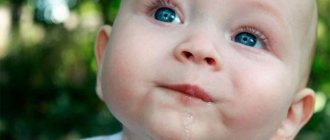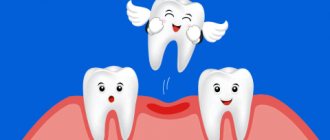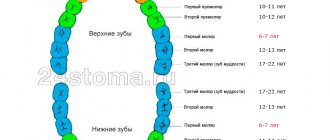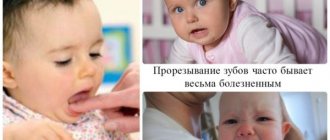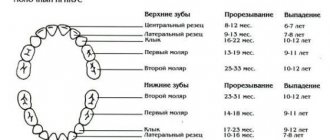The period when a baby's baby teeth erupt is both exciting and difficult for both the child and his parents. Children are often capricious during this period, sleep poorly, cry, and all because the appearance of their first teeth is accompanied by unpleasant sensations. Since the child himself cannot tell his parents about his problem and always reacts the same way to any type of discomfort, it is difficult for mom and dad to differentiate the signs of teething under the child’s behavior.
In this article, especially for young parents, we have collected as much useful information as possible about the eruption of baby and permanent teeth in children, so that you understand what is happening and how to act in this situation to help the baby.
When and what teeth do children erupt?
In fact, the rudiments of baby teeth are formed in children even during the period of embryonic development, and at the moment when they begin to grow and erupt, the rudiments of permanent teeth are already being prepared in the child’s jaw to replace them.
If we talk about the “gold standard”, then the teething scheme looks like this:
- 6-8 months – two central lower incisors.
- At approximately 8 months, the upper central incisors also appear.
- At 8-12 months, the upper lateral incisors appear.
- Around the same time (10-12 months), the lower lateral incisors erupt.
- At 14-20 months, the first chewing teeth appear on the lower and upper jaws (one on each side - 4 in total).
- At 1.5-2 years, the first canines erupt in the upper and lower dentition.
- At the age of 2-3 years, the following chewing teeth appear.
Despite the specified timing, each baby has his own individual teething order. So, some babies show their first teeth at 4.5 months, while others are “delayed” and, on the contrary, grow a little later than the established age. Such features depend on many factors, including gender (usually girls take the lead in teething).
Reasons for the atypical timing of the eruption of elements
Only a dentist can accurately determine the causes of abnormal teething in children. However, there are several common violations that lead to the problem:
- improper metabolism;
- lack of calcium in the body;
- disturbances in the functioning of the endocrine system;
- gastrointestinal pathologies;
- incorrect direction of the tooth axis.
Anomalies of the dentition can be associated not only with the timing of the appearance of elements, but also with the color, location, and size of the units in the row. If a child is already born with teeth, they are usually removed. Such situations are diagnosed quite rarely, and they indicate intrauterine disorders in the baby.
Formation of milk bite
The process of building a human bite has 5 stages, and all of them occur in childhood.
Each of the five stages is important for the final formation of the entire dental system and dental occlusion:
The first stage is from birth to 6 months (before the appearance of the first teeth).
The second stage is the period of eruption of all baby teeth in a child (6 months - 3 years).
The third stage is the period of jaw growth, preparation for the natural change of milk teeth to permanent ones (3-6 years).
The fourth stage is the time of active growth of the jaws and the eruption of permanent teeth (6-12 years).
The fifth stage is 12-15 years old, when the child’s baby teeth have already changed and all teeth are permanent.
Correct formation of the primary dentition is one of the main conditions for the development of a correct permanent dentition in a child.
How many teeth should a child have?
By the age of three, a child usually already has a full set of twenty primary teeth, and until about 6 years old, their number remains unchanged. Adolescents aged 13 to 18 years should normally have from 28 to 32 molars (depending on the presence of eights, which may erupt after 21 years or not appear at all).
Symptoms of baby teeth erupting
Each baby reacts individually to the eruption of baby teeth, however, there are characteristic symptoms by which parents can understand that this is happening:
- heavy salivation;
- redness and swelling of the gums;
- itching
Severe itching and sometimes even painful sensations make the child capricious. He becomes restless, which disrupts his sleep. To somehow relieve the itching, children put toys in their mouths and intensively rub their gums. Children often refuse to eat or eat with less appetite. What does the gum look like when teeth come in? Changes in the condition of the gums are one of the criteria by which parents can differentiate teething. The gums in this place look inflamed - they turn red, swell, and immediately at the site of tooth eruption they become white.
However, the biggest concerns about the child’s condition are cough, runny nose, and fever during teething. Indeed, the appearance of baby teeth in its symptoms can resemble colds, and it is difficult for parents without experience to understand whether the baby is sick or is just teething.
First of all, you need to understand that both fever and cough during teething in children are acceptable reactions. Cough, hoarseness, and runny nose are most often the result of excessive salivation. For the same reason, during teething, babies develop a rash on the chin and around the mouth.
Another frequently asked question from parents is what kind of stool can a child have when teething? During a particularly acute period of teething, babies may have weak stools, which is associated with general irritation of the nervous system and has nothing to do with eating disorders.
However, it must be taken into account that when babies are teething, they are more susceptible than usual to various infections. If unpleasant symptoms (fever, diarrhea, cough) do not go away on their own after 2-3 days, the child should be examined by a doctor.
How long does teething take for babies?
With normal development and growth, baby teeth erupt within a few days (2-8 days), and the most unpleasant symptoms usually appear within about 2 days.
The period of formation of the primary occlusion ends at 2-3 years, and at this moment the baby has 20 primary teeth.
Problems and complications when the first teeth appear
Sore gums, fever, poor appetite and indigestion are, although unpleasant, acceptable symptoms during the eruption of baby teeth.
In some cases, children experience complications:
- long delay - can be either a genetic feature or pathological adentia (if the child has not formed the rudiments of teeth);
- formation of a hematoma (cyst) - in this case, the gum above the growing tooth acquires a dark purple tint, then a lump or hematoma appears in this place, which may be due to both difficult eruption (the tooth cannot cope with the mucous membrane) and other reasons;
- violation of the order of teething;
- aphthous stomatitis - rashes on the mucous membrane in the form of purulent ulcers;
- enamel hypoplasia – occurs in babies under 10 months of age;
- malocclusion - improper closure of teeth, crowding, possible problems with the eruption of permanent teeth in the future.
If your baby experiences “difficult eruption” of primary teeth or you encounter the listed complications, you should definitely consult a pediatrician. If the formation of a primary occlusion is clearly incorrect, consult an orthodontist.
Why do my gums hurt when teething?
To appear on the surface, the tooth needs to pass through the jaw bone and gum tissue. Although this is a natural process, it can be painful, because the tooth “grows” through the gum and violates its integrity. The gums become sensitive during tooth eruption, and pain may occur when pressing on them. These unpleasant sensations go away as soon as the tooth moves apart the gum and looks out.
What to do when teething: advice for young parents
Now that you know what is happening to your child, you can draw up a rough action plan aimed at making the process of the appearance of the first teeth as easy as possible for the baby.
Tips for moms and dads:
- 1
Stay calm. It’s not easy for a child anyway, and your anxiety and irritation will only negatively affect the baby’s well-being. - 2
Surround your baby with love and tenderness. Remember that small children feel calm and safe only in the arms of loving parents.
- 3
Provide your baby with special gum toys that will help relieve itching and make teething easier.
- 4
Turn on the increased antibacterial protection mode (frequent ventilation, sterilization of toys, pacifiers, etc.), since during this period the child can easily catch an infection.
If your baby's gums are bothering you a lot, you can use a special teething gel. This product has a mild anesthetic effect, relieves itching and pain. Regarding the choice of gel, it is better to consult your pediatrician. He will tell you which drug is suitable for your baby’s age and has a safe composition.
What to do when the temperature rises? Doctors recommend avoiding the use of antipyretic drugs, as the body fights infections by raising the temperature. If hyperthermia is very high, you should consult a pediatrician, he will recommend what medications and in what dosage can be given to the baby. Under no circumstances use folk remedies or medications without first consulting a doctor!
Norm or pathology
Can teeth be cut at 3 months? The earliest age for the eruption of the first elements is considered to be three months of age. Dentists consider it normal for the first teeth to appear at 3 months of age. If the incisors appear earlier than the expected period, then the child should be shown to a therapist. The early appearance of elements on the surface of the gums may signal hormonal disruptions occurring in the body.
The appearance of baby teeth on the surface is accompanied by a number of distinctive symptoms:
- Pain in the gums. Because of this, the child puts fists and foreign objects into his mouth. At this moment, it is important for adults to ensure that there are no small toys or objects near the child that could get into the respiratory tract.
- Deterioration of the oral cavity. The gums swell and redden, becoming more sensitive to external irritants. In some cases, due to teething, the child may experience slight redness of the throat.
- Irritability and increased tearfulness of the baby. The symptom is associated with constant pain in the area of the eruption of the element. At this moment, children become more active and faster.
- Disorders of the digestive tract, manifested by loose stools, regurgitation, and rare bouts of vomiting.
- Temperature increase. The symptom is due to the fact that when teething, the newborn’s body is vulnerable to bacterial and viral pathogens.
Formation of permanent bite
The development of permanent teeth is a long and complex process. The formation of permanent teeth begins at approximately 3 years of age, when the child’s primary bite is already fully formed.
Preparations for their eruption are ongoing, but changes occur gradually, so most often we don’t even notice them. Meanwhile, the child:
- jaws grow and expand;
- the distance between baby teeth increases (this is important, since permanent teeth are larger and by the time they erupt there should be enough space for them in the dentition).
Timing of eruption of permanent teeth in children
The order of growth of permanent teeth in children is mainly hereditary. In approximately 50% of cases, the molars (sixes) grow first. Second molars appear at 7-8 years of age. Around the same time, the incisors are replaced.
The first permanent tooth appears in children at 6 years of age, and the complete formation of the permanent dentition of the lower and upper jaw is completed at 12-13 years of age. After this, the roots of permanent teeth continue to form and this process ends by the age of 15.
Teething symptoms
Unlike baby teeth, permanent teeth in children erupt almost always painlessly and with virtually no symptoms.
In rare cases, during the teething period the child’s well-being may deteriorate:
- the child gets tired quickly;
- drowsiness appears;
- gums become inflamed;
- salivation increases, a runny nose appears;
- The gums itch where the tooth grows, and when chewing, painful sensations appear.
Problematic eruption of permanent teeth in children
Problems that may arise during the eruption of permanent (molar) teeth:
- 1
Growth retardation – after a baby tooth falls out, the permanent one is in no hurry to appear for 6 months or longer.
- 2
Bite pathology. It may be associated with premature eruption of permanent teeth (if the baby teeth have not yet fallen out), or lack of space on the jaw for normal tooth growth.
- 3
Hyperdentia - permanent teeth grow second row behind the milk teeth. The reason is the strong fixation of the temporary tooth in the socket, as a result of which the permanent tooth “chooses” a more convenient direction for growth.
- 4
Caries and its complications.
Signs of teething
You can understand that the first molar will soon come out by the following signs - the gums begin to swell and hurt greatly, which is accompanied by increased salivation. In this case, a similar picture can begin several months before the actual appearance of the teeth themselves. Sleep becomes restless, the child is capricious, due to severe discomfort, children refuse some meals, and an irresistible urge to put various objects in their mouth appears.
Once teething enters the active stage, you will notice a thin white line on the gum or a whitish protrusion. If you lightly tap the exposed teeth with a teaspoon, you will hear a slight clicking sound, some parents do this, but if you decide to do this test, do it very carefully.
How to correctly distinguish between symptoms
Some signs characteristic of the onset of the appearance of molars in children often overlap with the symptoms of infectious diseases. Therefore, if you have any doubts about this, it is better to seek advice from a specialist.
Pay attention to the temperature - it can rise to 38.5–39 degrees and stay for two days, this is normal. Paracetamol in small quantities is suitable for knocking it down, but if after this period the indicators do not decrease, you should not hesitate to go to the doctor.
Watery diarrhea also often occurs due to excessive salivation; normally, this repeats up to 2-3 times a day. If this period is exceeded and blood inclusions appear, there is already a reason to make an appointment with a specialist.
Regarding the runny nose, clear discharge that lasts 3-4 days does not cause concern; it is enough for parents to clear the sinuses of it in a timely manner.
If this period is exceeded, and the snot becomes whitish or greenish, do not hesitate to go to the doctor. The same applies to a cough, if it lasts more than two days and is accompanied by sputum, consultation is needed.
How to help your child: recommendations from Amel Dental doctors
To cope with the discomfort caused by the eruption of permanent teeth, it is enough to massage the child’s gums. If your gums are inflamed, a teething gel will help relieve the inflammation (your dentist will help you choose the right one).
What to do if complications develop?
- 1
Bite problems in children are easier to eliminate than in adults, so if there are defects, you should consult an orthodontist.
- 2
Caries requires immediate treatment, otherwise there is a chance that the child will lose a tooth in childhood.
- 3
If dental growth is delayed, you should immediately see a doctor. One of the main reasons for delayed eruption of permanent teeth in children is immune disorders.
Gel for teething. How to choose?
If a child becomes restless and capricious during the teething period, first of all you need to create a calm environment for him, pay him more attention, pick him up more often, hug him, and talk to him.
Pain can be relieved mechanically or with medications. You can massage the gums with a clean finger or a rubber brush, let your baby suck on a dryer or chew on a teether, especially a cooled one. There are special dental gels to relieve gum pain in babies during teething. The advantages of children's gum gels are that they quickly relieve pain.
There are many more disadvantages to using them. The main two:
- If the gel contains the anesthetics benzocaine and lidocaine, they can be dangerous to the child’s health. Such drugs provide pain relief for a short time - the medicine is washed off with saliva and swallowed. It is difficult to accurately calculate the dosage when squeezing the gel out of the tube. If you also exceed the number of applications of the medicine recommended by the instructions, you may exceed the permissible limit. An overdose of lidocaine threatens with such dire consequences as convulsions, breathing problems, heart rhythm disorders - even death.
- Herbal gels provide mild pain relief, but help relieve inflammation. Their action does not give quick results. An allergic reaction to herbal components is possible, so after the first use you need to monitor the child’s reaction.
If you still decide to use a teething gel for your baby, choose either a herbal gel or a combination drug with an anesthetic and herbs. It will help relieve acute pain and reduce inflammation. But use combination gels very carefully, only as a last resort when other methods do not work and the child is in severe pain.
It is important!
Teething is a difficult period for the baby and his parents, but it is a natural stage of growing up, which allows the transition to solid food after breast milk.
How to keep children's primary and permanent teeth healthy?
Both baby and molar teeth of a child require careful care. The health of future permanent teeth depends on how healthy the child's baby teeth were. The main concern of parents is quality care, timely treatment and preservation of baby teeth until the time comes for their natural replacement with permanent ones.
What should you do for this?
- Carefully monitor the condition of your baby’s teeth and regularly take him for examinations to the dentist in order to diagnose caries in time.
Prevention of caries is one of the main conditions for the health of a child’s future permanent teeth. You can protect your teeth by ensuring regular high-quality oral hygiene. One of the most effective measures to prevent caries in children is the dental procedure of sealing the fissures of baby teeth.
- Treat caries in a timely manner.
Unfortunately, temporary teeth have very thin enamel and not a very dense structure, so when affected by a carious infection, they are quickly destroyed. With timely diagnosis, caries is treated quickly and without complications - in dentistry, baby teeth are filled with safe materials. Thanks to modern materials and technologies in dentistry, it is even possible to restore baby teeth with severe destruction. In some cases, if the baby tooth could not be saved, and there is still a lot of time left before the permanent teeth erupt, prosthetics of temporary teeth is used.
- Take care of proper nutrition.
Food is an important source of useful vitamins and microelements, so it is important that the child’s diet is varied and balanced.
Both baby and molar teeth of a child require careful care. The habit of brushing teeth and observing the rules of oral hygiene is formed in children from the appearance of their first teeth. Maintaining the health of children's teeth requires very little time and effort, but all this effort will help your child keep his teeth healthy for a long time!
First teeth
When to expect
The baby's milk teeth are formed at the 7th–8th week of intrauterine development, and the permanent ones at the end of the 4th month of pregnancy. In total, a child develops 20 baby teeth, while 32 permanent teeth. To provide the baby with a Hollywood smile, the expectant mother needs to eat properly throughout the nine months of pregnancy. There are no calcium preparations that are 100% absorbable, so it is very important to get “natural” calcium from food, especially cottage cheese. And, of course, the pregnant woman herself needs to have all her teeth treated - now there are very gentle technologies for this.
The eruption of the first milk teeth in most cases begins at 3–8 months of the baby’s life and ends closer to three years. But it also happens that children are born with one or two teeth, or teeth may erupt in the first weeks of life. Often the timing of teething depends on genetic characteristics, but much more strongly on other factors. Diseases of the baby also affect the teeth (for example, with rickets, frequent ARVI and dyspepsia, teeth erupt later). It’s worth paying attention to the nature of your diet, the quality of drinking water, even the climate! On average, northern residents start teething a little later than southerners. Sometimes teething is delayed, and the first tooth appears closer to a year. Usually there is nothing wrong with this. It is believed that it is not so much the timing that speaks about a child’s health, but rather the order in which teeth erupt. If it is broken, pay attention to this fact and show the baby to the pediatric dentist.
The process has started
The fact that the teething process has begun is indicated by profuse salivation. In addition, the baby begins to put into his mouth everything that comes to hand. This means that the gums are itchy, causing him discomfort. Trying to relieve the itching, the baby instinctively acts correctly - micromassage of the gums improves microcirculation in them, teeth erupt easier and faster. During this period, provide your child with teethers: hypoallergenic silicone toys filled with water. The teether should not be cooled in the freezer - only in the refrigerator: otherwise the baby will get hurt on a hard surface. If the gums are very swollen and the baby is crying in pain, use special dental gels that have a mild local anesthetic effect.
For most children, the teething process goes quite smoothly. There may be short periods of anxiety, disturbances in daily routine and nutrition. Sometimes even teething is accompanied by diarrhea, runny nose, cough and fever. And during the period when teeth appear, the baby is vulnerable to all kinds of infections. The baby’s immunity is weakening these days, and it is easier for him to “catch” the virus, so you should not attribute the deterioration of the condition only to the teeth. If a child has a fever when a tooth is being cut, you need to look for another inflammatory source in the body.
At 6 months
The baby usually boasts central lower incisors. This is a reason to start brushing your teeth. Why so early? Baby teeth are small and sharp, have an uneven wavy edge, stand close to each other and, as a rule, have a yellowish tint. These teeth have a low degree of mineralization. Their enamel and dentin are very thin. All this contributes to the rapid occurrence and spread of caries. In order to prevent it, you need to regularly brush your teeth: for this you can use various massage brushes, which not only accustom the child to hygiene, but also facilitate the teething process itself. We immediately teach you how to brush your teeth correctly - from the gums to the edges, with slightly “sweeping”, semicircular movements, and in no case horizontally. If possible, brush your teeth after every meal (and at least twice a day). Isn't there such a possibility? Give the baby something to drink - the water will wash away any remaining food.
At 8 months
The upper central incisors usually erupt.
At 9 months,
the upper lateral incisors appear.
At 11 months,
many children's lower lateral incisors are already in place!
By the age of one year, a baby normally already has eight teeth
.
But there may not be any - delayed teething occurs in 25% of cases with normal psychomotor development of the child. In extremely rare cases, the absence of teeth is associated with adentia - the absence of their rudiments. This can be checked by a pediatric dentist using radiovisiography. By 13–15 months,
the upper first molars appear first, followed by the lower ones.
From the age of one year, your baby can brush his teeth with children's toothpaste and a special children's brush. The service life of the brush is no more than 2 months, even if it looks like new. Many kids swallow the tasty pasta. There is no need to be afraid of this if it is for children and its quantity is no more than a pea. Of course, until 2–2.5 years of age, teeth brushing should be done with the help and then under the watchful supervision of the mother.
At 18 months
fangs erupt.
Typically, these teeth cause more problems than others; their eruption is more painful, and this process is often accompanied by discomfort. At 20 months,
the second molars erupt.
And sometimes already at this age the mother can notice the first problems. Doctors reassure: carious baby teeth are not a reason to worry that permanent teeth will also be bad. As practice shows, there is no pattern here. Of course, if parents do not neglect disease prevention and dental hygiene. At 2.5 years old, a child normally has a full set of baby teeth.
There are 20 of them - 10 on each jaw .
Baby teeth don’t last very long – soon they will begin to fall out and permanent ones will appear in their place. Usually the change of teeth begins at about 5–6 years and lasts until the age of 20, when wisdom teeth erupt.
Starting from 6 months, you must come for a preventive examination twice a year. When this becomes a habit, the baby will not be afraid of doctors, and by the age of 7–8 years (when a visit to the clinic can no longer be avoided) he will sit completely calmly in the dental chair
In order for your baby’s teeth to grow strong and healthy, you need to start taking care of them almost before conception. It’s also better to meet the dentist early
Timing of eruption and loss of baby teeth
| Upper teeth | |||
| Tooth name | Period of eruption | Teething order | Drop date |
| Central incisor | 8 months – 1 year | 2 | 6–7 years |
| Lateral incisor | 9 months – 1 year 2 months | 3 | 7–8 years |
| Fang | 1 year 3 months – 1 year 10 months | 7 | 10–12 years |
| First molar | 1 year – 1 year 6 months | 5 | 9–11 years |
| Second molar | 2 years – 2 years 8 months | 10 | 10–12 years |
| Lower teeth | |||
| Central incisor | 6 months –10 months | 1 | 6–7 years |
| Lateral incisor | 10 months –1 year 4 months | 4 | 7–8 years |
| Fang | 1 year 4 months – 2 years | 8 | 9–12 years |
| First molar | 1 year 2 months – 1 year 7 months | 6 | 9–11 years |
| Second molar | 1 year 10 months – 2 years 8 months | 9 | 10–12 years |

